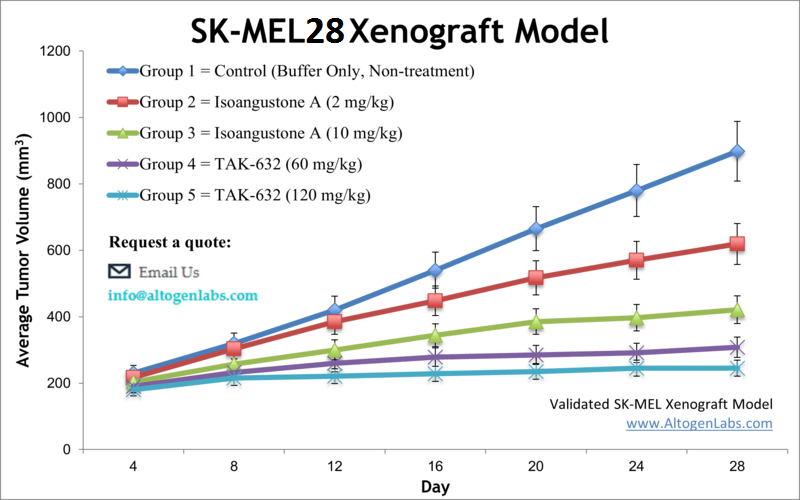
SKMEL28 Xenograft Model
SK-MEL-28 is a human melanoma cell line that was derived from a skin lesion of a patient with malignant melanoma. Melanoma is a subtype of cancer that affects melanocytes, the cells responsible for pigment production in the skin. Symptoms can include an unusual or new skin growth, a change in skin color or a change in an existing mole. Since melanomas affect the skin, they can occur anywhere on the body. Risk factors include poor immune function, family history, and a large amount of moles; UV light exposure such as the sun or tanning devices can directly cause melanoma. The SKMEL-28 cell line was first deposited by Memorial Sloan Kettering Cancer Center and were isolated from a 51 year old male with malignant melanoma. Since then SKMEL28 cells have been used for various melanoma research studies. A 2012 Oncogene study (Xing et al.) used the SKMEL28 model to investigate (V600E) BRAF mutated cancers. Results indicated that concurrent mutations (inactivation) of PTEN and RB1 in such cancers attenuate RAF dependence and suggest a need to screen for PTEN and RB1 mutations in patients who may be treated with RAF or MEK inhibitors. Jung et al. (Carcinogenesis 2014) used the SKMEL28 xenograft model to investigate the antitumor/preventative effects of acacetin, a Robinia p seudoacacia (black locust) flavonoid. Results demonstrated that acacetin treatment suppressed EGF-induced transformation of tumor cells and targeted the P110 subunit of PI3-K resulting in reduction in xenograft tumor growth. This supports acacetin as a chemoprevention for melanoma. Finally, the Koo et al. PNAS article (2002) used SKMEL28 xenografts to investigate the mechanism of lethal factor, the Bacillus anthracis (anthrax) principal virulence factor, against melanoma. Results demonstrated that lethal factor triggers apoptosis in a MAPK-inactivation mediated mechanism. This dually supports 1) the use of MAPK inhibition for melanoma treatment and 2) suggests that due to elevated cAMP caused by anthrax edema toxin, melanoma production is heightened which may contribute to the blackened eschars seen in cutaneous anthrax. The SKMEL28 cell line is used to create the CDX (Cell Line Derived Xenograft) SKMEL28 xenograft mouse model. The SKMEL28 xenograft model has been used as a model for studying novel melanoma therapies and preventions.
Basic Study Design
- SKMEL28 cells are maintained in exponential growth phase under aseptic conditions.
- Cells are trypsinized and cell count viability is determined using a trypan blue exclusion assay (98-99% of cell viability is required). SKMEL28 cell suspension is adjusted to appropriate density.
- Each mouse is singly subcutaneously injected into the right flank with 106 cells in 100 µL of a Matrigel- SKMEL28 cell suspension.
- The injection sites are palpated up to three times weekly until tumors are established to an average size of 75-150 mm3 as measured via digital calipers.
- Animals are randomized into treatment groups. Administration of test compound is performed according to the pre-established treatment schedule.
- Mice weights are measured and recorded 3 times weekly; tumors are measured and recorded daily.
- End of study is reached when tumor size reaches 2,000 mm3 or the predetermined size limit per approved IACUC protocol.
- Final necropsy and tissue collections are performed for appropriate downstream analysis. Tumors are excised, weighed and documented by digital imaging. Tumors and tissues can be stabilized in RNAlater, snap frozen in LN2 or prepared for histology.
